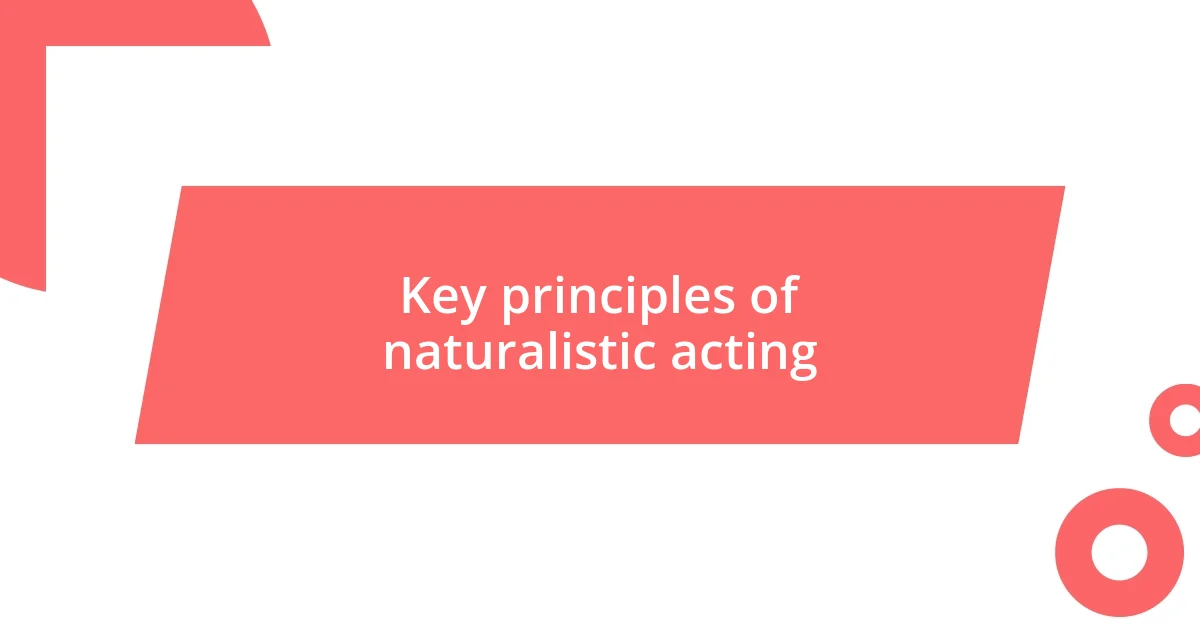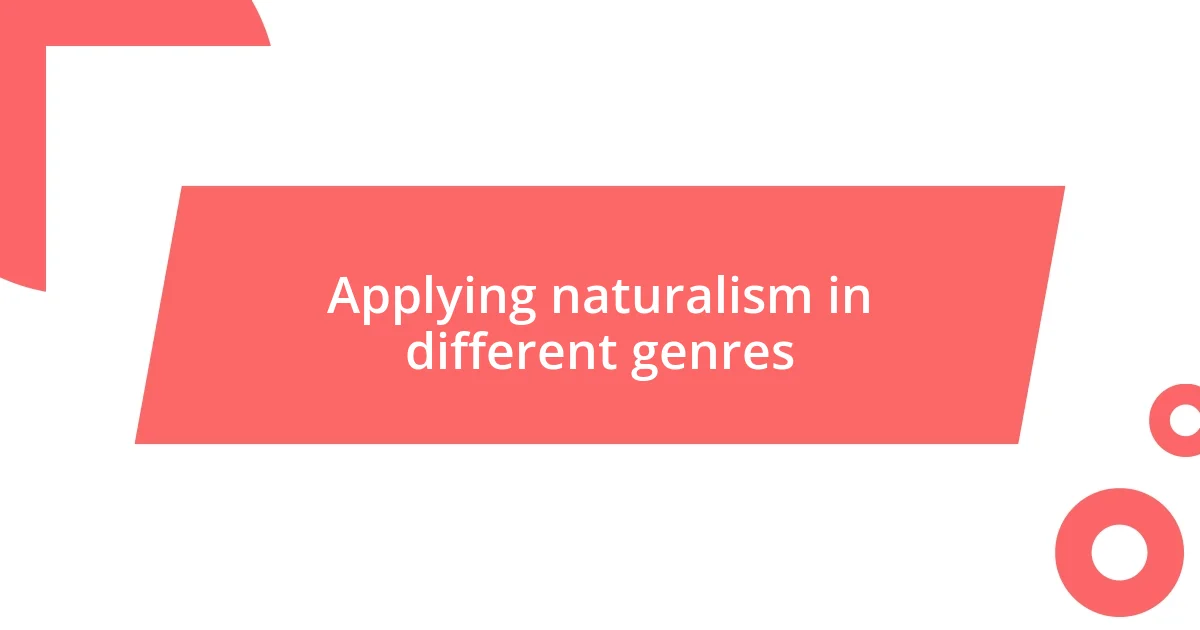Key takeaways:
- Naturalistic acting emphasizes authenticity by encouraging actors to draw from personal emotions and experiences, enhancing audience connection.
- The movement originated in the late 19th century as a response to exaggerated theatrical styles, focusing on realism and the complexities of everyday life.
- Key principles include authenticity, observation, subtlety, character depth, and the influence of environment, all of which inform genuine character portrayals across genres.

Understanding naturalistic acting styles
Naturalistic acting focuses on portraying characters in a believable and relatable manner. I remember my first time performing a scene where I had to express grief. Instead of a dramatic display, I opted for subtle body language and soft-spoken lines. The audience’s connection felt real, almost as if they were witnessing a genuine moment of vulnerability.
It’s fascinating to realize how naturalistic acting encourages performers to tap into their own emotions and experiences. Have you ever felt overwhelmed on stage, not because of the lines, but because the situation mirrored something personal? I once channeled my own experiences of loss into a monologue, creating a bridge between my inner world and the character’s reality. That moment taught me how authenticity in acting can evoke a profound response from the audience.
In essence, naturalistic acting invites actors to explore human experiences with honesty and depth. I often find myself asking, “How would I react in this character’s situation?” This internal dialogue allows me to craft performances that resonate with others—turning a simple line into a powerful exchange of emotions. Each performance becomes a shared journey, where the audience and I navigate the complexities of life together.

Historical background of naturalism
Naturalism in acting has its roots in the late 19th century, emerging as a reaction against the more exaggerated styles of melodrama and romanticism. The movement sought to bring a sense of realism to the stage, reflecting the complexities of everyday life. I’ve often found myself drawn to this shift; it’s as though a veil was lifted, allowing actors to showcase the raw aspects of human emotion.
During this era, playwrights like Émile Zola emphasized the influence of environment and heredity on human behavior. This is something I deeply resonate with in my own acting journey. In one of my performances, I portrayed a character trapped by their circumstances, and I couldn’t help but think how our backgrounds shape who we are. It was a reminder that, like artists, we are products of our environment.
This approach not only revolutionized theatre but also laid the groundwork for modern acting techniques. As I reflect on my practice, I see how incorporating naturalistic elements invites vulnerability into my performances. It feels liberating to abandon pretense and share a piece of my soul with the audience, drawing them into a world that feels genuine and relatable.
| Key Aspect | Naturalism |
|---|---|
| Origin | Late 19th century |
| Key Playwright | Émile Zola |
| Main Focus | Realism and everyday life |
| Reaction To | Melodrama and romanticism |

Key principles of naturalistic acting
Naturalistic acting hinges on specific principles that foster authenticity in performances. It’s about immersing oneself in the character’s world while embracing the nuances of human behavior. I recall a rehearsal where I struggled to understand my character’s motives; diving deep into their background helped me see things from their perspective. That moment reinforced my belief that understanding the character’s life is essential for genuine portrayal.
Here are some key principles to keep in mind:
- Authenticity: Embrace real emotions and situations, allowing personal experiences to inform your portrayal.
- Observation: Study people and life around you to capture the intricacies of human interaction.
- Subtlety: Focus on understated expressions and actions, avoiding excessive dramatization.
- Character Depth: Develop a comprehensive backstory to inform your character’s motivations.
- Environment Influence: Acknowledge how surroundings shape behavior and emotions.
By embodying these principles, I strive to create moments on stage that resonate with my audience, as if they are witnessing the unfiltered essence of life itself.

Techniques for developing characters
To develop authentic characters, I often rely on emotional memory techniques. This involves recalling personal experiences that evoke similar feelings to those my character might be experiencing. For instance, I once dug deep into my memories of heartbreak to portray a character dealing with loss, and it was astounding how those genuine emotions translated into my performance. Have you ever felt like tapping into your own history could unlock something deeper in your character work?
Another technique I find invaluable is improvisational exercises. These not only foster spontaneity, but they also help me explore various facets of my character. In one rehearsal, I was prompted to interact with other cast members without a script. It surprised me how much I discovered about my character—through their reactions and relationships with others. It’s almost like peeling back layers to reveal something new each time.
Finally, I believe in the power of physicality to inform character development. Exploring how my character moves or carries themselves can offer profound insights into their psyche. During one show, I decided to alter my posture to reflect my character’s insecurity, which instantly transformed how I portrayed their emotional state. This left me pondering: doesn’t our body tell a story as much as our words do?

Emotional authenticity in performances
Emotional authenticity is at the heart of what makes a performance resonate. I remember a time when I had to portray a character undergoing a significant personal crisis. Instead of relying solely on the script, I allowed myself to feel the weight of that crisis in my own life. This connection not only brought genuine emotion to my performance but also drew the audience into a shared experience of vulnerability. Have you ever felt that deep link between your own emotions and the characters you portray?
When I strive for authenticity, I often share my personal stories with my fellow actors as a way to break down barriers. In one rehearsal, I revealed my struggle with self-doubt, which unexpectedly encouraged others to share their own stories. This exchange created an atmosphere of trust, and as a result, our performances became richer and more layered. It’s fascinating how openness can transform a rehearsal space into a true emotional landscape.
Sometimes, I challenge myself to step outside my comfort zone to evoke raw emotion. For instance, during one scene, I enacted a moment of pure shock, recalling a time I received unexpected news. The visceral reaction I had was palpable, and it reminded me that real emotions—even discomfort—can profoundly influence a character’s authenticity. How much of our own experiences can we channel to enhance our performances? I believe the answer lies in embracing those moments and allowing ourselves to be vulnerable on stage.

Training exercises for naturalistic acting
One of my favorite training exercises for naturalistic acting is the voice journal. I set aside time each week to record my thoughts and feelings about the day, focusing on details like my emotions and reactions to various situations. This not only helps me connect with my own inner landscape but also sharpens my ability to articulate feelings on stage. Have you ever tried expressing your true self in a completely unfiltered way? It’s an enlightening process that often reveals unexpected layers to my characters.
Another effective technique is the sensory exploration exercise. I immerse myself in different environments and focus on the sights, sounds, and smells around me. For example, during one session at a bustling market, I noticed how the scent of fresh spices and the lively chatter of vendors ignited particular memories. In my acting, these sensory cues allow me to summon authentic emotions that resonate with my characters’ experiences. Isn’t it fascinating how our surroundings can influence our performances?
I also engage in scene work with an emphasis on listening and reacting genuinely to my scene partners. In one rehearsal, I was paired with someone I had little chemistry with initially. Instead of forcing a connection, I chose to truly listen to them, responding to their words as if they were real. The dynamic shifted remarkably, transforming our interaction into something believable and raw. It begs the question: how much can authentic connection amplify our performances in ways we don’t expect? For me, the answer has been transformative.

Applying naturalism in different genres
In applying naturalism across different genres, it’s fascinating how the essence of authenticity remains paramount, no matter the context. I once had the opportunity to act in a stylized fantasy piece where the characters were exaggerated and larger-than-life. Despite the vivid colors and fantastical elements, I found that grounding my character in real emotions and experiences made our interactions feel genuine. It made me wonder, can heightened realities still convey the truth of human emotions? I believe they can, as long as we remain true to ourselves.
While working on a contemporary drama, I noticed how the naturalistic approach demanded a different set of skills compared to the fantasy genre. In one scene, where my character faced betrayal, I tapped into a time in my life when trust was broken. This direct connection allowed me to deliver a performance that felt electric and raw, engaging the audience on a visceral level. This brings up an interesting thought: how does the genre shape our emotional responses as actors? My experience teaches me that, regardless of genre, the core of acting lies in sincere emotional expression and believable character portrayal.
When I explored a comedic role, I discovered that naturalism could, in fact, enhance humor. I recall a scene that required me to navigate awkward social interactions. By drawing from real-life situations rather than adopting a caricatured approach, I found humor in the truth of those uncomfortable moments. It makes me question: why is authenticity often overlooked in comedic contexts? I realize it holds incredible power; when we connect with our audience’s laughter and discomfort, we create a shared journey that enriches the performance.













